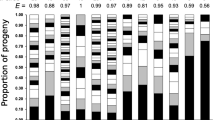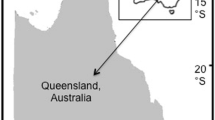Synopsis
Parental care in the Malawian cichlid fishPseudotropheus zebra ‘BB’ is extensive and exclusively maternal; males contribute only genetic material. The costs of searching for multiple mates (in this case risk of predation on orally incubated eggs) suggested that females should be monandrous; microsatellite genetypes of seven brooding females and their young, however, reveal extensive multiple paternity in this species, with a mean of 3.8 paternal individuals per brood. Polygynandry inP. zebra is probably not maintained by selection for genetically diverse offspring; potential explanations include avoidance of inbreeding, and bet-hedging on other male characteristics that females are unable to evaluate when selecting a mate. The observed degree of multiple paternity strongly suggests that females are free to choose mates as they will, a prerequisite of many theories positing sexual selection as a key element in Malawi chichlid evolution. It should also result in elevation of effective population sizes, and thus be antagonistic to runaway evolution of male secondary sexual characteristics, but not necessarily to other modes of sexual selection.
Similar content being viewed by others
References cited
Alcock, J. 1989. Animal behavior. Sinauer Associates, Sunderland. 596 pp.
Arnold, S.J. 1983. Sexual selection: the interface of theory and empiricism. pp. 67–108. In: P. Bateson (ed.) Mate Choice. Cambridge University Press, Cambridge.
Ausubel, F.M., R. Brent, R.E. Kingston, D.D. Moore, J.G. Seidman, J.A. Smith & K. Struhl (ed.). 1989. Short protocols in molecular biology. John Wiley & Sons. New York. 387 pp.
Avise, J. 1994. Molecular markers, natural history, and evolution, Sinauer Associates, Sunderland. 511 pp.
Barlow, G.W. 1991. Mating systems among cichlid fishes. pp. 173–190. In: M.H.A. Keenleyside (ed.) Cichlid Fishes. Chapman & Hall, London.
Chakraborty, R., T.R. Meagher & P.E. Smouse. 1988. Parentage analysis with genetic markers in natural populations. I. The expected proportion of offspring with unambiguous paternity. Genetics 118: 527–536.
Devlin, B., K. Roeder & N.C. Ellstrand. 1990. Fractional paternity assignment: theoretical development and comparison to other methods. Theor. Appl. Genet. 76: 369–380.
Dixon, A.F.G. 1989. Evolution and adaptive significance of cyclical parthenogenesis in aphids. pp. 289–297. In: A.J. Minks & P. Harrewijn (ed.) Aphids, Their Biology, Natural Enemies, and Control, Elsevier, Amsterdam.
Dominey, W.J. 1984. Effects of sexual selection and life history on speciation: species flocks in African cichlids and HawaiianDrosophila. pp. 231–250. In: A.A. Echelle & I. Kornfield (ed.) Evolution of Fish Species Flocks. University of Maine Press, Orono.
Eccles, D.H. & E. Trewavas. 1989. Malawian cichlid fishes. Lake Fish Movies, Herten. 334 pp.
Ellstrand, N.C. 1984. Multiple paternity in the fruits of the wild radishRaphanus sativus. Amer. Nat. 123: 819–828.
Fryer, G. & T.D. Iles. 1972. The cichlid fishes of the Great Lakes of Africa. Oliver Boyd, Edinborough. 641 pp.
Glesener, R.R. & D. Tilman. 1978. Sexuality and the components of environmental uncertainty. Amer. Nat. 112: 659–673.
Hardy, I.C.W. 1994. Sex ratio and mating structure in the parasitoid Hymenoptera. Oikos 69: 3–20.
Hert, E. 1992. Homing and home-site fidelity in rock-dwelling cichlids. Env. Biol. Fish. 33: 229–237.
Kirkpatrick, M. & M.J. Ryan. 1991. The evolution of mating preferences and the paradox of the lek. Nature 350: 33–38.
Konings, A. 1990. Cichlids of Lake Malawi. TFH Publications. Neptune City. 495 pp.
Korings, A. 1995. Malawi cichlids in their natural habitat, Cichlid Press, St. Leon-Rot. 352 pp.
Kornfield, I. 1991. Genetics, pp. 103–128. In: M.H.A. Keenleyside (ed.) Cichlid Fishes, Chapman & Hall, London.
Kornfield, I. & A. Parker, 1996. Molecular systematics of a rapidly evolving species flock: the mbuna of Lake Malawi and the search for phylogenetic signal. In: T.D. Kocher & C. Stepien (ed.) Molecular Systematics of Fishes, Academic Press, New York (in press).
Lewis, D.S.C., P.N. Reinthal & J. Trendall. 1986. A guide to the fishes of Lake Malawi National Park. World Wildlife Foundation. Gland. 71 pp.
Lincoln, S. & M. Daly. 1991. PCPRIMER (computer software). Whitehead Institute, Cambridge.
Marsh & A.J. Ribbink. 1986. Reproductive seasonality in a group of rock-frequenting cichlids in Lake Malawi. J. Zool. Soc. Lond. 209: 9–20.
McElroy, D.M. & I. Kornfield. 1990. Sexual selection, reproductive behavior, and speciation in the mbuna species flock of lake Malawi. Env. Biol. Fish. 28: 273–284.
McKaye, K.R. 1991. Sexual selection and the evolution of the cichlid fishes of Lake Malawi. pp. 241–257. In: M.H.A. Keenleyside (ed.) Cichlid Fishes, Chapman & Hall, London.
McKaye, K.R. & W.N. Gray, 1984. Extrinsic barriers to gene flow in rock dwelling cichlids of Lake Malawi: microhabitat heterogenecity and reef colonization. pp. 169–184. In: A.A. Echelle & I. Kornfield (ed.) Evolution of Fish Species Flocks, University of Maine Press, Orono.
Meyer, A., T.D. Kocher, P. Basasibwaki & A.C. Wilson. 1990. Monophyletic origin of Lake Victoria cichlids suggested by mitochondrial DNA sequences. Nature 347: 550–553.
Milligan, B.G. & C.K. McMurray. 1993. Dominant vs. codominant genetic markers in the estimation ot male mating success. Mol. Ecol. 2: 275–283.
Moran, P. & I. Kornfield. 1993. Retention of an ancestral polymorphism in the mbuna species flock (Pisces: Cichlidae) of Lake Malawi. Mol. Biol. Evol. 10: 1015–1029.
Moran, P. & I. Kornfield. 1995. Evidence of a population bottleneck and extreme philopatry in the mbuna species flock (Teleostei: Cichlidae) of Lake Malawi. Mol. Biol. Evol. 12: 1085–1093.
Moran, P., I. Kornfield & P. Reinthal. 1994. Molecular systematics and radiation of the haplochromine cichlids (Teleostei: Perciformes) of Lake Malawi. Copeia 1994: 274–228.
Mrowka, W. 1987. Oral fertilization in a mouthbrooding cichlid fish. Ethology 74: 293–296.
Nichols, R.A. & R.K. Butlin. 1989. Does runaway sexual selection work in finite populations? J. Evol. Biol. 2: 299–313.
Noakes, D.L.G. 1991. Ontogeny of behavior in cichlids. pp. 209–224. In: M.H.A. Keenleyside (ed.) Cichlid Fishes, Chapman & Hall, London.
Owen, R.B., R. Crossley, T.C. Johnson, D. Tweddle, I. Kornfield, S. Davison, D.H. Eccles & D.E. Engstrom. 1990. Major low levels of Lake Malawi and implications for speciation rates in cichlid fishes. Proc. Roy. Soc. Lond. 240-B: 519–553.
Parker, G.A. 1983. Mate quality and mating decisions. pp. 141–166. In: P. Bateson (ed.) Mate Choice, Cambridge University Press, Cambridge.
Parker, G.A. 1984. Sperm competition and the evolution of animal mating strategies, pp. 1–60. In: R.L. Smith (ed.) Sperm Competition and the Evolution of Animal Mating Systems, Academic Press, Orlando.
Parker, G.A. 1992. Snakes and female sexuality. Nature 355: 395–396.
Philippi, T. & J. Seger. 1989. Hedging one's evolutionary bets, revisited. Trends Ecol. Evol. 4: 41–44.
Queller, D.C., J.E. Strassmann & C.R. Hughes. 1993. Microsatellites and kinship. Trends Ecol. Evol. 8; 285–288.
Ribbink, A.J. & D.S.C. Lewis. 1982.Melanochromis crabro sp. nov.: a cichlid fish from Lake Malawi which feeds on ectoparasites and catfish eggs. Neth. J. Zool. 32: 72–87.
Ribbink, A.J., B.A. Marsh, A.C. Marsh, A.C. Ribbink & B.J. Sharp. 1983. A preliminary survey of the cichlid fishes of rocky habitats of Lake Malawi. S. Afr. J. Sci. 18: 149–310.
Row, L., G. Arnquist & J.J. Kruppa. 1994. Sexual conflict and the evolutionary ecology of mating patterns: water striders as a model system. Trends Ecol. Evol. 9: 289–294.
Scholz, C.A. & B.R. Rosendahl. 1988. Low lake stands in Lakes Malawi and Tanganyika, East Africa, delineated with multifold seismic data. Science 240: 1645–1648.
Sugg, D.W. & R.K. Chesser. 1994. Effective population sizes with multiple paternity. Genetics 137: 1147–1155.
Taborsky, M. 1994. Sneakers, satellites, and helpers: parasitic and cooperative behavior in fish reproduction. Adv. Stud. Behav. 23: 1–100.
Trendall, K. 1988. Recruitment of juvenile mbuna (Pisces: Cichlidae) to experimental rock shelters in Lake Malawi, Africa, Env. Biol. Fish. 22: 117–131.
Trivers, R.L. 1985. Social evolution. Benjamin/Cummings Publishing, Menlo Park. 462 pp.
Turner, G.F. 1994. Speciation mechanisms in Lake Malawi cichlids: a critical review. Arch. Hydrobiol. 44: 139–160.
Watson, P.J. 1991. Multiple paternity as genetic bet-hedging in female Sierra Dome spiders,Lynyphia litigiosa. Anim. Behav. 41: 343–360.
Wilcockson, R.W., C.S. Craun & T.H. Day. 1995. Heritability of a sexually selected character expressed in both sexes. Nature 374: 158–159.
Williams, G.C. 1992. Natural selection: domains, levels, and challenges. Oxford University Press, Oxford. 208 pp.
Author information
Authors and Affiliations
Rights and permissions
About this article
Cite this article
Parker, A., Kornfield, I. Polygynandry inPseudotropheus zebra, a cichlid fish from Lake Malawi. Environ Biol Fish 47, 345–352 (1996). https://doi.org/10.1007/BF00005049
Received:
Accepted:
Issue Date:
DOI: https://doi.org/10.1007/BF00005049




